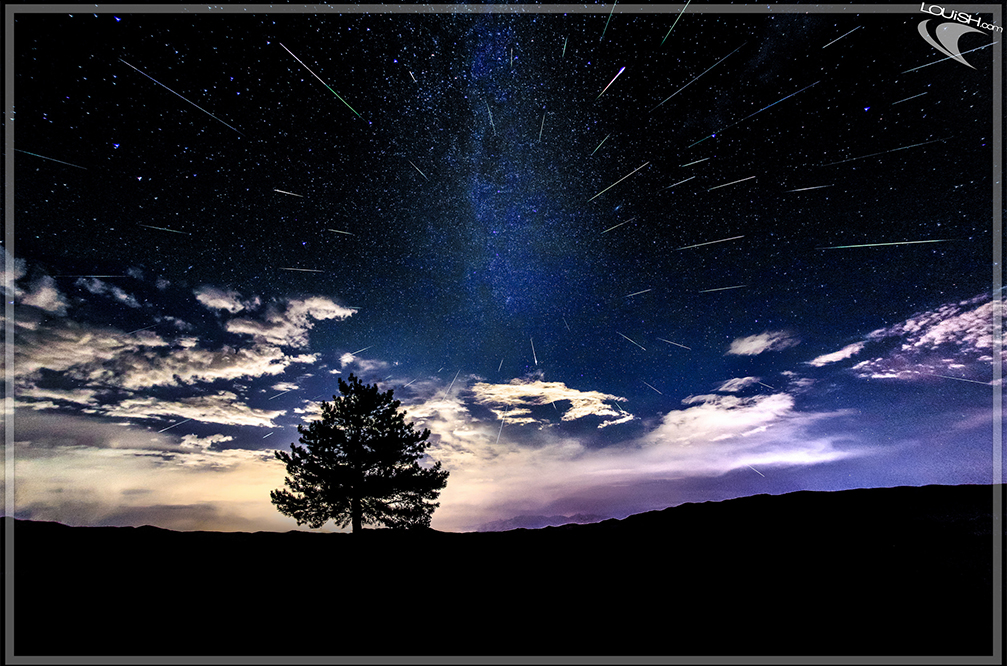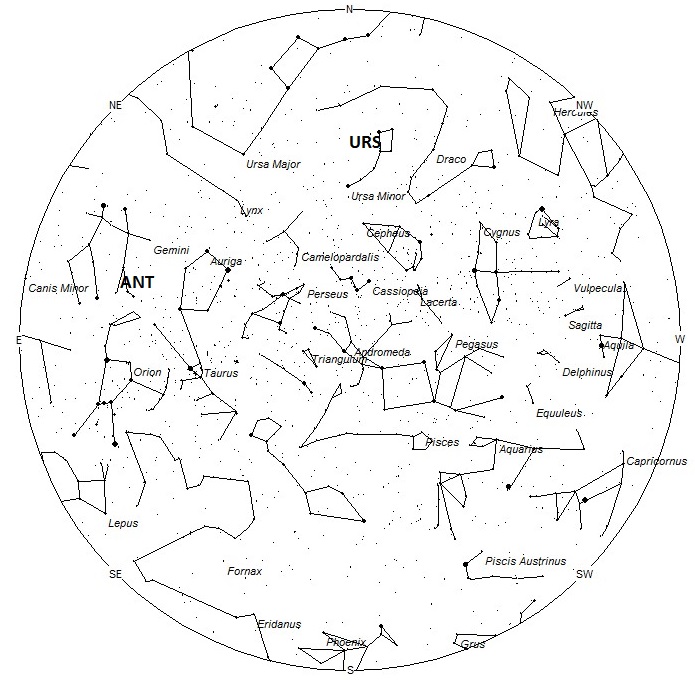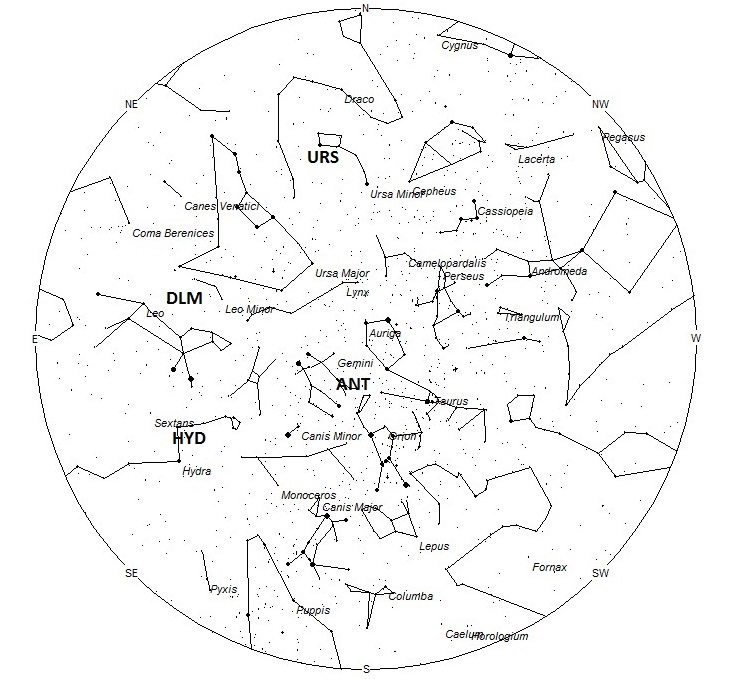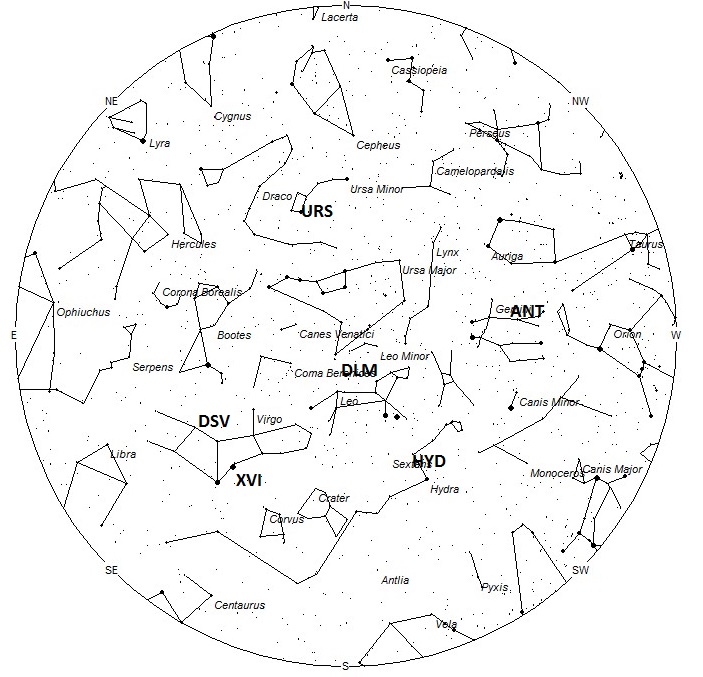
During this period the moon reaches its last quarter phase on Wednesday December 21st. At this time the moon will be located 90 degrees west of the sun and will rise near midnight local standard time (LST). This weekend the waning gibbous moon will rise during the late evening hours and will spoil the remainder of the night with bright moonlight. Conditions improve slightly with each passing night as the moon’s phase lessens and the moon rises later each morning. The estimated total hourly meteor rates for evening observers this week is near 4 as seen from mid-northern latitudes (45N) and 3 as seen from tropical southern locations (25S). For morning observers the estimated total hourly rates should be near 13 as seen from mid-northern latitudes (45N) and 8 as seen from tropical southern locations (25S). Morning rates are reduced during this period due to the bright moonlight. The actual rates will also depend on factors such as personal light and motion perception, local weather conditions, alertness and experience in watching meteor activity. Note that the hourly rates listed below are estimates as viewed from dark sky sites away from urban light sources. Observers viewing from urban areas will see less activity as only the brightest meteors will be visible from such locations.
The radiant (the area of the sky where meteors appear to shoot from) positions and rates listed below are exact for Saturday night/Sunday morning December 17/18. These positions do not change greatly day to day so the listed coordinates may be used during this entire period. Most star atlases (available at science stores and planetariums) will provide maps with grid lines of the celestial coordinates so that you may find out exactly where these positions are located in the sky. A planisphere or computer planetarium program is also useful in showing the sky at any time of night on any date of the year. Activity from each radiant is best seen when it is positioned highest in the sky, either due north or south along the meridian, depending on your latitude. It must be remembered that meteor activity is rarely seen at the radiant position. Rather they shoot outwards from the radiant so it is best to center your field of view so that the radiant lies at the edge and not the center. Viewing there will allow you to easily trace the path of each meteor back to the radiant (if it is a shower member) or in another direction if it is a sporadic. Meteor activity is not seen from radiants that are located below the horizon. The positions below are listed in a west to east manner in order of right ascension (celestial longitude). The positions listed first are located further west therefore are accessible earlier in the night while those listed further down the list rise later in the night.
These sources of meteoric activity are expected to be active this week.
Now that the activity from particles produced by comet 2P/Encke have ceased encountering the Earth, the Taurid showers for 2016 are over and we resume reporting activity from the Anthelion (ANT) radiant. This is not a true radiant but rather activity caused by the Earth’s motion through space. As the Earth revolves around the sun it encounters particles orbiting in a pro-grade motion that are approaching their perihelion point. They all appear to be radiating from an area near the opposition point of the sun, hence the name Anthelion. These were once recorded as separate showers throughout the year but it is now suggested to bin them into their category separate from true showers and sporadics. There are several lists that have the Chi Orionids currently active, but we include them with the Anthelions as the celestial positions overlap. This radiant is a very large oval some thirty degrees wide by fifteen degrees high. Activity from this radiant can appear from more than one constellation. The position listed here is for the center of the radiant which is currently located at 06:36 (099) +23. This position lies in western Gemini, 3 degrees southwest of the 3rd magnitude star known as Mebsuta (epsilon Geminorum). Since the Anthelion radiant is so large, activity may also appear from eastern Taurus, northeastern Orion, southeastern Auriga as well as western Gemini. This radiant is best placed near 0100 LST when it lies on the meridian and is highest in the sky. Rates at this time should be near 2 per hour as seen from the northern hemisphere and less than 1 per hour from south of the equator. With an entry velocity of 30 km/sec., the average Anthelion meteor would be of slow velocity.
The sigma Hydrids (HYD) are active from November 26 through December 21, with maximum activity occurring on December 6. The radiant is currently located at 08:56 (134) +00, which places it in western Hydra, 3 degrees southwest of the 4th magnitude star known as theta Hydrae. These meteors are best seen near 0300 LST when the radiant lies highest above the horizon. Current rates should be less than 1 per hour no matter your location. With an entry velocity of 61 km/sec., most activity from this radiant would be of swift speed.
The December Leonis Minorids (DLM) are a shower of long duration active from December 6th through January 18th. Maximum occurs near December 21st when rates may reach 3 an hour and this source is the strongest in the sky, except for the Ursids on the 22nd. The radiant is currently located at 10:40 (160) +30. This position lies in eastern Leo Minor, close to the faint star known as 42 Leo Minoris. These meteors are best seen near 0500 LST when the radiant lies highest above the horizon. At 63 km/sec. the December Leonis Minorids produce mostly swift meteors. These meteors are not well seen from the southern hemisphere.
The December chi Virginids (XVI) was discovered by Japanese observers using the data of SonotaCo. This source is active from December 8-24 with maximum activity occurring on the 16th. The current radiant location is at 12:58 (195) -12, which places it in south-central Virgo, 7 degrees west of the bright star known as Spica (alpha Virginis). Current rates would most likely be near 1 per hour no matter you location. These meteors are best seen during the last dark hour before dawn, when the radiant lies highest above the horizon in a dark sky. At 69 km/sec. the December Chi Virginids would produce mostly swift meteors.
The December sigma Virginids (DSV) was discovered by John Greaves using the data of SonotaCo. IMO video cameras confirmed that this source is active during most of December. Visual observers have their best chance at catching these meteors from December 17-30. Peak rates occur near December 24th. The current radiant location is at 13:36 (204) +05 which places it in northern Virgo, 5 degrees north of the star known as Heze (zeta Virginis). Current hourly rates should be near 1 no matter your location. These meteors are best seen during the last dark hour before dawn, when the radiant lies highest above the horizon in a dark sky. At 68 km/sec. the December Sigma Virginids would produce mostly swift meteors.
Meteors from the Ursids (URS) should begin appearing on December 17th. This major radiant is active from the 17th through December 24th with peak rates occurring on the 22nd. The radiant is currently located at 14:00 (210) +76, which places it just east of the 4th magnitude star known as 5 Ursae Minoris. The bright 2nd magnitude star Kochab (beta Ursae Minoris) also lies 3 degrees to the southeast. This area of the sky is circumpolar for most of the northern hemisphere. Unfortunately it lies lowest in the sky at dusk and highest in a dark sky just before dawn. Due to the high northern declination, these meteors are strictly a northern hemisphere display. Rates are less than 1 per hour away from maximum activity. On the morning of the 22nd, rates usually range from 5-10 shower members per hour, occasionally reaching 25 per hour during rare outbursts. At 33 km/sec. the Ursids would produce meteors of average velocity.
As seen from the mid-northern hemisphere (45N) one would expect to see approximately 6 sporadic meteors per hour during the last hour before dawn as seen from rural observing sites. Evening rates would be near 3 per hour. As seen from the tropical southern latitudes (25S), morning rates would be near 4 per hour as seen from rural observing sites and 2 per hour during the evening hours. Locations between these two extremes would see activity between the listed figures. Morning rates during this period are reduced due to moonlight.
| SHOWER | DATE OF MAXIMUM ACTIVITY | CELESTIAL POSITION | ENTRY VELOCITY | CULMINATION | HOURLY RATE | CLASS |
| RA (RA in Deg.) DEC | Km/Sec | Local Standard Time | North-South | |||
| Anthelion (ANT) | – | 06:36 (099) +23 | 30 | 01:00 | 2 – 1 | II |
| sigma Hydrids (HYD) | Dec 07 | 08:56 (134) +00 | 61 | 03:00 | <1 – <1 | II |
| Dec. Leonis Minorids (DLM) | Dec 20 | 10:40 (160) +30 | 63 | 05:00 | 3 – 1 | II |
| Dec. chi Virginids (XVI) | Dec 17 | 12:58 (195) -12 | 69 | 08:00 | 1 – 1 | IV |
| Dec. sigma Virginids (DSV) | Dec 24 | 13:36 (204) +05 | 68 | 09:00 | 1 – 1 | IV |
| Ursids (URS) | Dec 22 | 14:00 (210) +76 | 33 | 10:00 | <1 – <1 | I |
 American Meteor Society
American Meteor Society



I was excited to see your post on this as I was outside tonight and saw a shooting star with a green color and probably the biggest I’ve ever seen with the naked eye.. the meteors I am familiar with are white streaks across the sky. This was bright enough to be in my peripheral vision and I turned my head in time to see the green meteor. I’d love to get more information from you on what I saw.. if these are typically bigger? What causes the green color?
Jessica and All,
It sounds as if you witnessed a fireball, which is a meteor that is larger than normal. The green color was probably caused by an element that was predominate in the makeup of the meteor. Usually it is nickel or copper which causes a meteor to glow with a greenish color.
I hope this helps!
Robert Lunsford
Hi Robert. I’m in Adelaide, South Australia (35° S, 139° E) and about midnight here, on Christmas Eve 2016, I witnessed a shooting star traveling from North to South, in the sky directly above me. I wondered if anyone could help me understand what that might have been? It seems like such an unusual trajectory… ! thanks
Meteors (tiny bits of rock, ice, and metal) can actually travel in any direction
in the sky. It all depends on their path in space as they intersect the Earth.
if you have any more questions about this, let me know!
Robert Lunsford
American Meteor Society